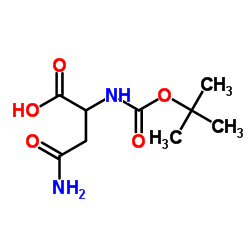Boc-Asn
Modify Date: 2025-08-21 09:48:57

Boc-Asn structure
|
Common Name | Boc-Asn | ||
|---|---|---|---|---|
| CAS Number | 142847-17-4 | Molecular Weight | 232.234 | |
| Density | 1.3±0.1 g/cm3 | Boiling Point | 481.7±40.0 °C at 760 mmHg | |
| Molecular Formula | C9H16N2O5 | Melting Point | 179ºC | |
| MSDS | N/A | Flash Point | 245.1±27.3 °C | |
| Name | 4-amino-2-[(2-methylpropan-2-yl)oxycarbonylamino]-4-oxobutanoic acid |
|---|---|
| Synonym | More Synonyms |
| Density | 1.3±0.1 g/cm3 |
|---|---|
| Boiling Point | 481.7±40.0 °C at 760 mmHg |
| Melting Point | 179ºC |
| Molecular Formula | C9H16N2O5 |
| Molecular Weight | 232.234 |
| Flash Point | 245.1±27.3 °C |
| Exact Mass | 232.105927 |
| PSA | 123.20000 |
| LogP | 0.27 |
| Vapour Pressure | 0.0±2.6 mmHg at 25°C |
| Index of Refraction | 1.497 |
| InChIKey | FYYSQDHBALBGHX-UHFFFAOYSA-N |
| SMILES | CC(C)(C)OC(=O)NC(CC(N)=O)C(=O)O |
Synonym:t-Butoxycarbonyl apsargin Section 2 - COMPOSITION, INFORMATION ON INGREDIENTS
Risk Phrases: None Listed. Section 3 - HAZARDS IDENTIFICATION EMERGENCY OVERVIEW
Not available. Potential Health Effects Eye: May cause eye irritation. Skin: May cause skin irritation. May be harmful if absorbed through the skin. Ingestion: May cause irritation of the digestive tract. May be harmful if swallowed. Inhalation: May cause respiratory tract irritation. May be harmful if inhaled. Chronic: Not available. Section 4 - FIRST AID MEASURES Eyes: Flush eyes with plenty of water for at least 15 minutes, occasionally lifting the upper and lower eyelids. Get medical aid. Skin: Get medical aid. Flush skin with plenty of water for at least 15 minutes while removing contaminated clothing and shoes. Ingestion: Get medical aid. Wash mouth out with water. Inhalation: Remove from exposure and move to fresh air immediately. Notes to Physician: Treat symptomatically and supportively. Section 5 - FIRE FIGHTING MEASURES General Information: As in any fire, wear a self-contained breathing apparatus in pressure-demand, MSHA/NIOSH (approved or equivalent), and full protective gear. Extinguishing Media: Use water spray, dry chemical, carbon dioxide, or chemical foam. Section 6 - ACCIDENTAL RELEASE MEASURES General Information: Use proper personal protective equipment as indicated in Section 8. Spills/Leaks: Vacuum or sweep up material and place into a suitable disposal container. Section 7 - HANDLING and STORAGE Handling: Avoid breathing dust, vapor, mist, or gas. Avoid contact with skin and eyes. Storage: Store in a cool, dry place. Store in a tightly closed container. Section 8 - EXPOSURE CONTROLS, PERSONAL PROTECTION Engineering Controls: Use adequate ventilation to keep airborne concentrations low. Exposure Limits CAS# 142847-17-4: Personal Protective Equipment Eyes: Not available. Skin: Wear appropriate protective gloves to prevent skin exposure. Clothing: Wear appropriate protective clothing to prevent skin exposure. Respirators: Follow the OSHA respirator regulations found in 29 CFR 1910.134 or European Standard EN 149. Use a NIOSH/MSHA or European Standard EN 149 approved respirator if exposure limits are exceeded or if irritation or other symptoms are experienced. Section 9 - PHYSICAL AND CHEMICAL PROPERTIES Physical State: Solid Color: white Odor: Not available. pH: Not available. Vapor Pressure: Not available. Viscosity: Not available. Boiling Point: Not available. Freezing/Melting Point: 179 - 182 deg C Autoignition Temperature: Not available. Flash Point: Not available. Explosion Limits, lower: Not available. Explosion Limits, upper: Not available. Decomposition Temperature: Not available. Solubility in water: Specific Gravity/Density: Molecular Formula: C9H16N2O5 Molecular Weight: 232 Section 10 - STABILITY AND REACTIVITY Chemical Stability: Not available. Conditions to Avoid: Incompatible materials. Incompatibilities with Other Materials: Strong oxidizing agents, acids, bases, acid chlorides. Hazardous Decomposition Products: Nitrogen oxides, carbon monoxide, carbon dioxide. Hazardous Polymerization: Has not been reported Section 11 - TOXICOLOGICAL INFORMATION RTECS#: CAS# 142847-17-4 unlisted. LD50/LC50: Not available. Carcinogenicity: 4-Amino-2-[(tert-butoxycarbonyl)amino]-4-oxobutanoic acid - Not listed by ACGIH, IARC, or NTP. Section 12 - ECOLOGICAL INFORMATION Section 13 - DISPOSAL CONSIDERATIONS Dispose of in a manner consistent with federal, state, and local regulations. Section 14 - TRANSPORT INFORMATION IATA No information available. IMO No information available. RID/ADR No information available. Section 15 - REGULATORY INFORMATION European/International Regulations European Labeling in Accordance with EC Directives Hazard Symbols: Not available. Risk Phrases: Safety Phrases: S 24/25 Avoid contact with skin and eyes. WGK (Water Danger/Protection) CAS# 142847-17-4: No information available. Canada None of the chemicals in this product are listed on the DSL/NDSL list. CAS# 142847-17-4 is not listed on Canada's Ingredient Disclosure List. US FEDERAL TSCA CAS# 142847-17-4 is not listed on the TSCA inventory. It is for research and development use only. SECTION 16 - ADDITIONAL INFORMATION N/A |
| Safety Phrases | S24/25 |
|---|---|
| HS Code | 2924199090 |
| HS Code | 2924199090 |
|---|---|
| Summary | 2924199090. other acyclic amides (including acyclic carbamates) and their derivatives; salts thereof. VAT:17.0%. Tax rebate rate:13.0%. . MFN tariff:6.5%. General tariff:30.0% |
| Boc-Asn |
| Boc-DL-asparagine |
| Asparagine, N-[(1,1-dimethylethoxy)carbonyl]- |
| N-(tert-butoxycarbonyl)asparagine |
| Boc-D-asparagine |
| N-{[(2-Methyl-2-propanyl)oxy]carbonyl}asparagine |
| tert-Butoxycarbonyl-L-asparagine |